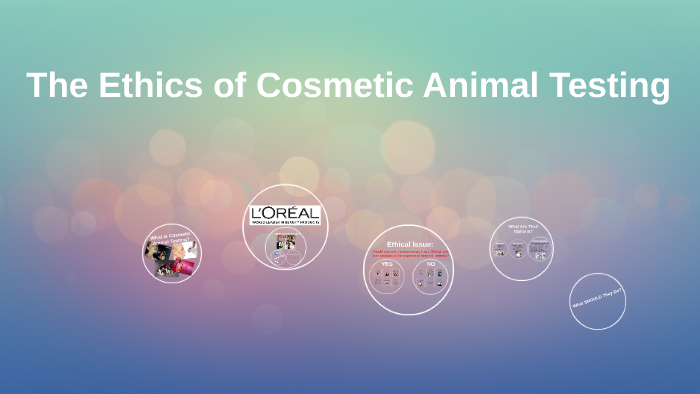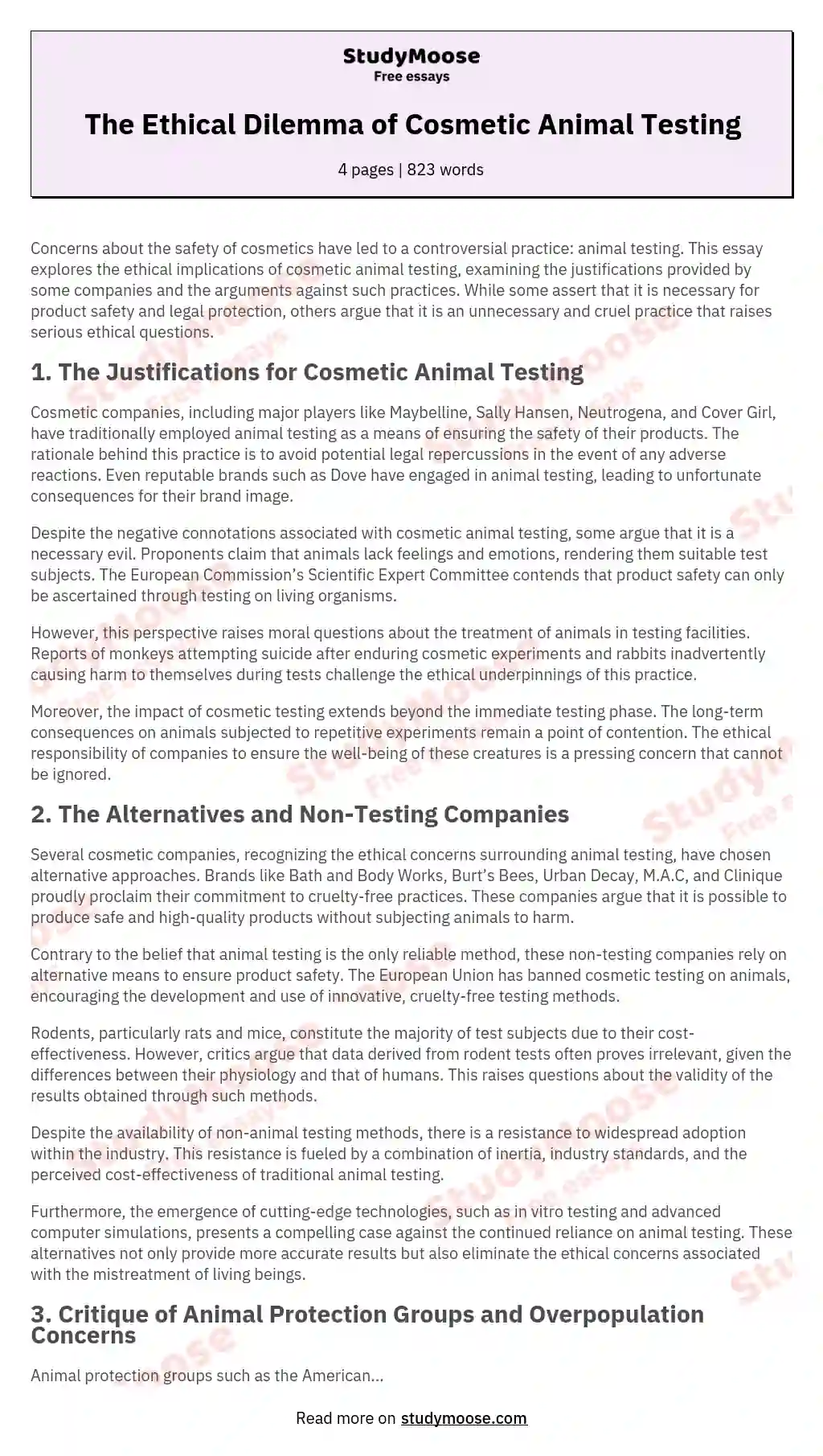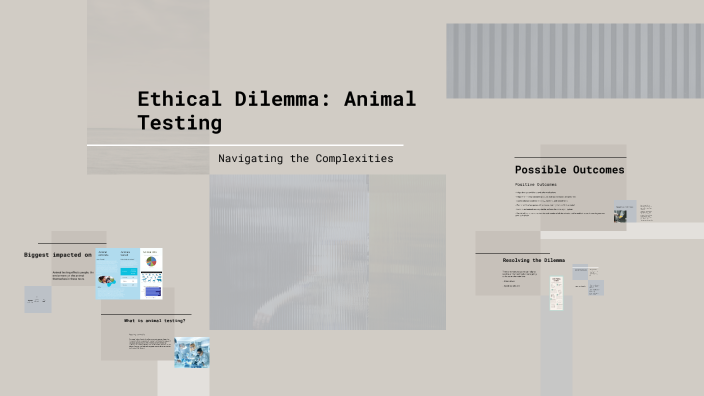The Ethical Dilemma Of Animal Testing In Cosmetics: A Comprehensive Overview
The Ethical Dilemma of Animal Testing in Cosmetics: A Comprehensive Overview
Related Articles: The Ethical Dilemma of Animal Testing in Cosmetics: A Comprehensive Overview
Introduction
With enthusiasm, let’s navigate through the intriguing topic related to The Ethical Dilemma of Animal Testing in Cosmetics: A Comprehensive Overview. Let’s weave interesting information and offer fresh perspectives to the readers.
Table of Content
The Ethical Dilemma of Animal Testing in Cosmetics: A Comprehensive Overview

The use of animals in cosmetic testing has been a subject of intense ethical debate for decades. While the practice has been widely condemned for its inherent cruelty, its historical role in ensuring the safety of cosmetic products cannot be ignored. This article aims to provide a comprehensive overview of animal testing in cosmetics, exploring its historical context, ethical considerations, and the ongoing efforts to replace it with more humane alternatives.
Historical Context: The Rise and Fall of Animal Testing in Cosmetics
The use of animals in scientific research dates back centuries, with early experiments often driven by curiosity rather than a structured scientific approach. In the early 20th century, the development of the cosmetics industry led to an increased demand for safety testing of ingredients and finished products. Animals, particularly rabbits, were seen as suitable models due to their physiological similarities to humans and their relatively low cost.
The Draize test, a notorious method for assessing the irritation potential of chemicals, was developed in the 1940s and became a standard practice for evaluating the safety of cosmetics. This test involved applying substances to the eyes of rabbits, often causing severe pain and inflammation. Despite the ethical concerns surrounding the Draize test, it remained widely used for decades, contributing to the perception of animal testing as a necessary evil in the cosmetics industry.
Ethical Considerations: The Moral Imperative for Change
The use of animals in cosmetic testing raises profound ethical concerns. Animals are sentient beings capable of experiencing pain, suffering, and distress, and their use in experiments raises questions about their right to be treated with respect and dignity.
Arguments against animal testing in cosmetics often cite the following:
- Lack of Relevance: While animals share some physiological similarities with humans, significant differences exist in their metabolism, skin, and eye structure. This can lead to inaccurate predictions of human responses, making animal testing unreliable for assessing the safety of cosmetic products.
- Cruelty and Suffering: Many animal testing methods involve inflicting pain, distress, and even death on animals. The Draize test, for instance, causes severe eye irritation and inflammation, while other tests involve skin irritation, toxicity, and even lethal injections.
- Alternatives Available: Advancements in science and technology have led to the development of sophisticated in vitro methods, human cell cultures, and computer modeling techniques that offer more accurate and humane alternatives to animal testing.
The Rise of Cruelty-Free Cosmetics: A Movement for Ethical Innovation
The growing awareness of the ethical implications of animal testing has fueled a global movement for cruelty-free cosmetics. This movement has seen a surge in demand for products that have not been tested on animals, leading to the emergence of a thriving market for cruelty-free brands.
Key factors driving this movement include:
- Consumer Awareness: Increased public awareness of the ethical issues surrounding animal testing has led to a growing preference for cruelty-free products. Consumers are increasingly demanding transparency from brands and actively seeking out products that align with their ethical values.
- Technological Advancements: The development of sophisticated in vitro methods, human cell cultures, and computer modeling techniques has provided viable alternatives to animal testing, making it possible to assess the safety of cosmetic products without harming animals.
- Legislative Changes: Several countries and regions have implemented legislation banning or restricting animal testing for cosmetics. The European Union, for example, has banned animal testing for cosmetic products and their ingredients since 2013.
The Future of Cosmetics Testing: Embracing Humane Alternatives
The future of cosmetics testing lies in embracing humane alternatives to animal testing. This involves a multi-pronged approach that combines:
- Continued Development and Validation of In Vitro Methods: Investing in research and development to improve the accuracy and reliability of in vitro methods, such as cell cultures, organ-on-a-chip technologies, and advanced computer modeling, is crucial for replacing animal testing.
- Promoting Transparency and Labeling: Clear and transparent labeling of products as "cruelty-free" or "not tested on animals" is essential for consumers to make informed choices. Standardized labeling practices and certification programs can help ensure the credibility of such claims.
- International Collaboration and Harmonization: International collaboration between governments, regulatory agencies, and industry stakeholders is crucial for harmonizing standards and promoting the adoption of humane alternatives to animal testing worldwide.
FAQs on Animal Testing in Cosmetics
1. Is animal testing still legal in all countries?
No. While animal testing for cosmetics is still legal in some countries, many have implemented bans or restrictions on the practice. The European Union, for instance, has banned animal testing for cosmetics and their ingredients since 2013.
2. What are the most common animals used in cosmetics testing?
Rabbits are frequently used in eye irritation tests, while rodents, such as rats and mice, are often employed in toxicity and skin irritation studies.
3. Are there alternatives to animal testing for cosmetics?
Yes, there are several alternatives available, including:
- In Vitro Methods: These methods use human cells or tissues grown in a laboratory setting to assess the safety of cosmetic ingredients.
- Human Cell Cultures: These cultures allow researchers to study the effects of cosmetic ingredients on human cells without using animals.
- Computer Modeling: Computer simulations can be used to predict the potential toxicity and irritation of cosmetic ingredients.
4. How can I ensure that the cosmetics I buy are cruelty-free?
Look for products that are certified by organizations like PETA (People for the Ethical Treatment of Animals) or Cruelty-Free International. These organizations verify that products have not been tested on animals and meet specific criteria for cruelty-free production.
5. What can I do to help end animal testing for cosmetics?
- Support Cruelty-Free Brands: Choose to purchase products from companies that are committed to cruelty-free practices.
- Advocate for Change: Contact your elected officials and urge them to support legislation banning animal testing for cosmetics.
- Educate Others: Share information about the ethical issues surrounding animal testing and encourage others to choose cruelty-free products.
Tips for Making Informed Choices about Cosmetics
- Read Labels Carefully: Look for labels that indicate "cruelty-free," "not tested on animals," or "vegan."
- Research Brands: Investigate the company’s policies on animal testing and their commitment to using humane alternatives.
- Support Organizations: Donate to organizations that are working to end animal testing for cosmetics.
Conclusion: A Call for Compassionate Innovation
The use of animals in cosmetics testing is a morally problematic practice that has no place in a compassionate and ethical society. The growing availability of humane alternatives and the increasing consumer demand for cruelty-free products offer a clear path forward. By embracing innovation and prioritizing ethical considerations, the cosmetics industry can move towards a future where beauty and compassion go hand in hand.




/GettyImages-1316412895-c10088ce59774d329891a246daa68dda.jpg)



Closure
Thus, we hope this article has provided valuable insights into The Ethical Dilemma of Animal Testing in Cosmetics: A Comprehensive Overview. We thank you for taking the time to read this article. See you in our next article!
You may also like
Recent Posts
- The Art Of Persuasion: A Comprehensive Guide To Makeup Product Label Design
- A Comprehensive Look At Mary Kay Cosmetics: Reviews, Insights, And Considerations
- Affordable Skin Care: A Guide To Effective Products Under INR 100
- Navigating The World Of Mary Kay Discounted Products: A Comprehensive Guide
- The Power Of High-Resolution Images: A Guide To Acquiring The Best Visuals For Your Projects
- The Power Of Reviews: Navigating The World Of Makeup Products
- Swiss Beauty Makeup: A Comprehensive Guide To Quality And Affordability
- Embracing Natural Beauty: Makeup Tips And Techniques For Women Over 50
Leave a Reply